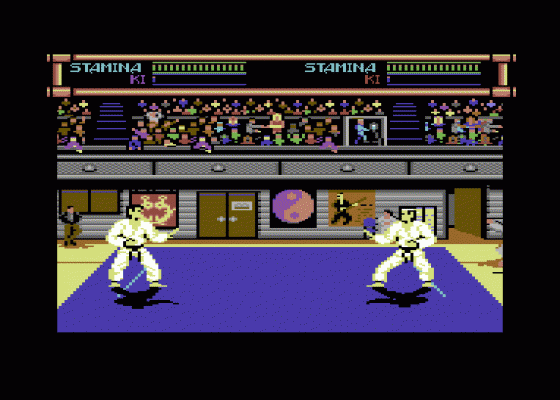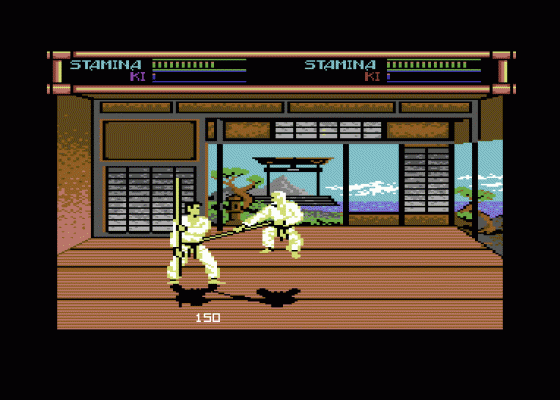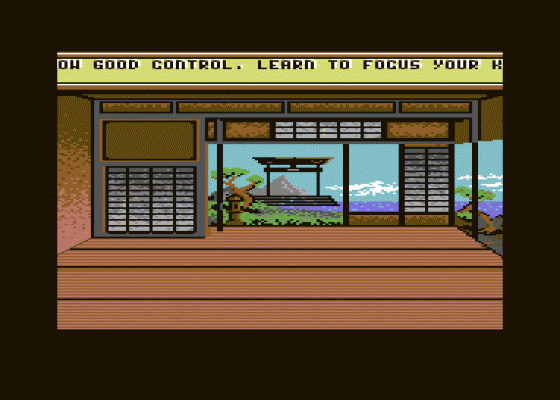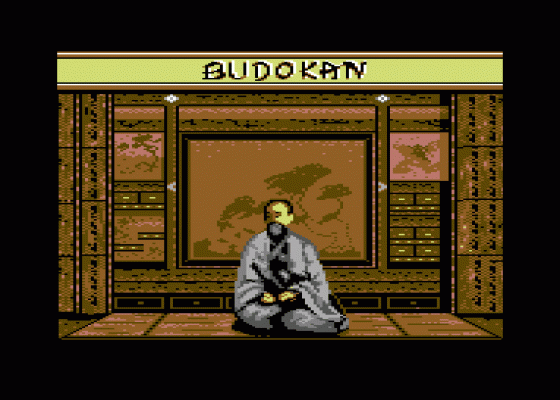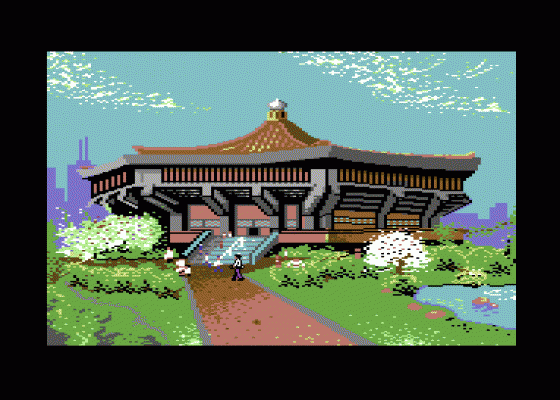
Commodore Format
 1st May 1992
1st May 1992
Categories: Review: Software
Author: Trenton Webb
Publisher: Electronic Arts
Machine: Commodore 64/128
Published in Commodore Format #20
Budokan (Electronic Arts)
The ancient Japanese made the beating, hitting and otherwise harming of folk an art form. Now you have the chance to learn these martial arts and fight at the Budokan tournament. Can four different destructive disciplines, training and tournament modes help this beat-'em-up battle its way to gameplay glory?
Bowing before the instructor, the lesson begins. Clad in white cotton gis, both combatants adopt their fighting stance. The instructor leaps in, throwing a deliberately slow punch which the student easily blocks. Both fighters back off gathering their inner strength for the next attack. The pupil is learning fast, but the instructor is letting him win - and dishing out some serious tutorial bruises.
This is Budokan: two fighters going head-to-head for the sheer hell of it. The kicks and blocks are learned as blows are exchanged and strategies formed. This is a no heads-up brawl, but a battle that has to be planned if you are to emerge not only as a victor, but with honour and a full set of teeth.
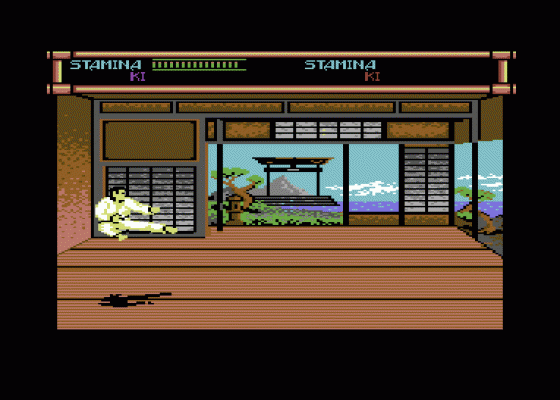
Budokan simulates the spirit of martial arts, allowing you to replicate spectacular fighting moves and capturing the philosophy behind Bushido - the way of the warrior (aka hitting people and getting away with it). Your fighter has an energy bar and a ki bar. Aggressive exertion and opponents' blows slowly sap the physical power. Ki is similarly sapped by attacks and damaging blows, but it represents the concentration needed to focus the mind. The higher a fighter's ki, the more damaging the next blow. When the physical energy reaches zero, the fighter is beaten. But when his ki hits rock bottom his blows simply have little effect and punches become pathetic wimpy slaps.
The amounts of ki and physical power a fighter has are not pre-set, but vary throughout the bout. A rapid series of kicks drains a fighter's energy, while resting between attacks allows it to regenerate. Ki is even more volatile though. Each blow - dished out or received - drains half of your ki, and again only finding a temporary respite from the fray will restore it. Trouble is, this means the other guy is getting a rest too, so while you gain in power so does he!
This is the gameplay enigma that lies at the heart of Budokan: when to take the gamble on an attack and when to take a bout-saving breather. Wasting effort on mis-timed attacks leaves you vulnerable, but waiting is rarely the safer option. In all, four disciplines - karate, kendo, nunchaku and bo - are the tools of Budokan's trade and learning how to use them effectively is the first half of this trial by fury.
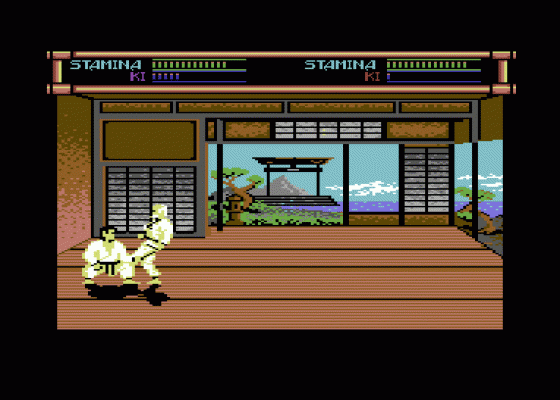
You control a character who has enrolled in a martial arts school that teaches four fighting techniques. By battling against masters (who let you win, because you're paying) on three different levels of difficulty, you learn how to attack and defend and how to make the most of your ki power - the key to success. Once you're fluent in the art of kicking, punching, hitting, bashing and otherwise slashing with obscure weaponry, it's time to go for the big basho and enter the Budokan. At the tournament you face a horde of folk who all want to kick your face off.
Before the battle you are given the low-down on their style - i.e. which weapon they will use - and their relative ability. You then select which one of your disciplines you are going to use to defeat them.
First off, life isn't that hard, as you can battle unarmed karate specialists using a kendo sword. But as you're only allowed to employ each discipline a set number of times, it isn't big or clever to go around wasting all your best weapons on saps. It's best to save them for the end-of-tournament matches, when you face some real heavy dudes.
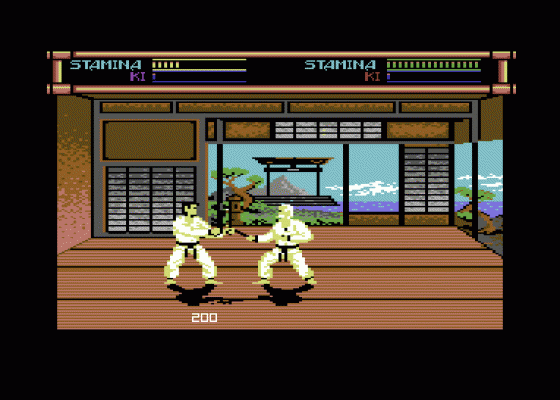
For variety you don't only fight peeps who share the same skills as you, but face an entire mediaeval Japanese armoury replete with Kusari-gama (an axe on a chain), Shuriken (throwing stars), Tonfa (American police truncheons), Yari (a javelin) and Naginata (a horse-crippling device on a stick). Each bout lasts until one of you falls over, a feat which requires as much careful ki management as the timing of your attacks.
Budokan adds an extra dimension to violence with the introduction of this balancing act. You have to gain the upper hand in both energy and ki terms, and then make this advantage count - by smacking the other guy harder than he can hit you. This system penalises the inaccurate and rewards fighting skill. Budokan succeeds as a fight that requires thought, and so it reaches gameplay levels rarely topped in waggling brawls.
The graphics complement the gameplay's style. Each style boasts its own sprites and animations to suit the moves allowed. The backdrops for the practice hall are atmospherically Japanese, and there are even some smart intermediate pics to help see you through the load between practice and tournament.
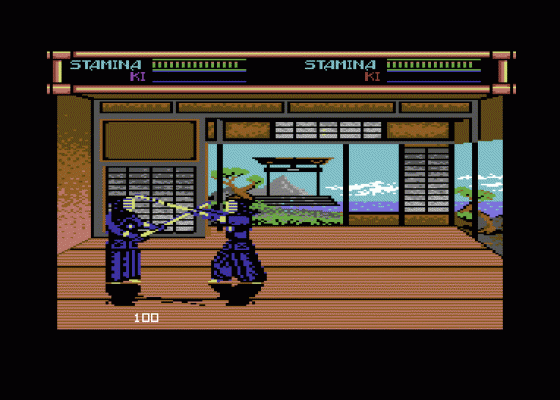
It is the loading though that drags down Budokan, a proud warrior of a game, to common street-fighter levels. It takes weeks to swap between disciplines, months to reach the tournament and years to play right the way through the game - and that's on disk! Well it doesn't take quite that long, but certainly feels like it.
And it is these inscrutable waits for loading that slowly sap the battle hunger that the balanced combat and good graphics work so hard to establish. It seems the desire to capture the essential martial arts spirit has gone too far. And these long mediative pauses between battles make you feel anything but calm and focused. When you're fighting, Budokan is good, very good. It brings out the balance that's badly needed if a beat-'em-up is to be worth playing. It looks the biz, it has variety, atmosphere and comes with a manual that's packed with Oriental facts. Yet the time it takes to get to each event is unbearable.
Budokan is a refreshingly different combat simulator, with depressingly familiar multiload habits.
Bad Points
- Incredibly slow loading makes you want to beat up your C64!
- No two player mode.
- Fights only ever go from left to right. No turning.
- Gets too tough too quickly at the tournament stage.
- A killer multi-load!
Good Points
- Masses of different fighting moves to try.
- Hit people with sticks, tonfas, clubs, hands and feet.
- Practice and tournament modes available.
- Great atmospheric graphics - very Japanese.
- Highly flexible combat system that needs thought.
- At last a fighting game with real depth!
Other Reviews Of Budokan: The Martial Spirit For The Commodore 64/128
Budokan (Electronic Arts)
A review by Carl Rowley (Zzap)


